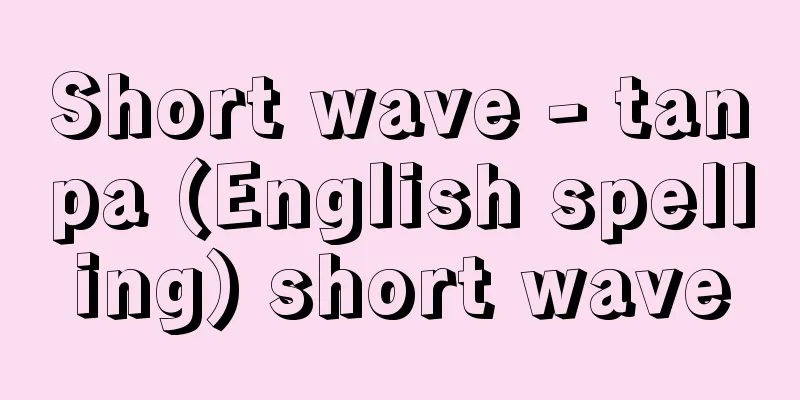Short wave - tanpa (English spelling) short wave

|
One of the names given to classify radio waves according to wavelength for the convenience of use. It is commonly used to refer to radio waves with wavelengths ranging from 100 meters to 10 meters and frequencies ranging from 3 megahertz to 30 megahertz. In terms of frequency band abbreviations under the Enforcement Regulations of the Radio Law, it corresponds to the HF band (decameter waves). In addition, the Ministry of Internal Affairs and Communications' Radio Station Operation Regulations state that the shortwave band ranges from 4,000 kilohertz to 26,175 kilohertz. Radio waves in this frequency band are diffracted and absorbed by the ionosphere, located more than 60 kilometers above the ground. They are subject to significant attenuation and fading (a phenomenon in which the received output fluctuates rapidly due to interference with radio waves) and cannot be used for short-distance communications. However, they are efficiently diffracted by the ionosphere (F-layer) located about 200 to 400 kilometers above the ground, and so have been used for long-distance communications for many years. Diffraction in the F-layer varies greatly depending on electron density. Therefore, the propagation distance varies greatly depending on the season, whether it is day or night, the intensity of solar irradiation, the number of sunspots, the latitude on Earth, and other factors. The frequency band to be used must be selected taking these conditions into consideration. Shortwave radio has been widely used for fixed-line communications, weather communications, international broadcasting, and radio communications between aircraft and ships. However, since the 1990s, high-speed, long-distance communications via satellite have become readily available, and shortwave radio is no longer used for anything other than international shortwave broadcasting, emergency calls for ships (Digital Selective Call, DSC), weather fax, fishing radio, and amateur radio. [Iwao Ishijima] [Reference items] | | |Source: Shogakukan Encyclopedia Nipponica About Encyclopedia Nipponica Information | Legend |
|
電波を利用上の便宜から波長により分類した呼び名の一つ。波長の範囲は100メートルから10メートルまで、周波数では3メガヘルツから30メガヘルツまでの電波を慣用的に総称していう。電波法施行規則による周波数帯の略称ではHF帯(デカメートル波)に相当する。また、総務省の無線局運用規則でいう短波帯は、4000キロヘルツから2万6175キロヘルツまでとなっている。 上空約60キロメートル以上にある電離層(電離圏)によって回折、吸収を受ける周波数帯の電波であって、近距離通信には減衰やフェージング(電波の干渉により受信出力が急激に変動する現象)が大きいので利用できないが、上空約200キロ~400キロメートルに存在する電離層(F層)で効率よく回折することから、遠距離通信には長年使用されてきた。F層での回折は電子密度によって大きく変化する。したがって伝播(でんぱ)距離は、季節、昼夜の別、太陽の照射度、太陽黒点の数、地球上の緯度などによって大きく変化する。これらの条件を考慮して、使用する周波数帯を選択しなくてはならない。 短波は固定通信、気象通信、国際放送、航空機や船舶の無線通信などに広く使用されてきた。しかし、1990年代以降は、衛星通信による高速度の長距離通信が容易に使用できるようになったために、短波国際放送、船舶の非常呼出し(デジタルセルコール、DSC:Digital Selective calling)、気象ファックス、漁業無線、アマチュア無線以外には使用されなくなっている。 [石島 巖] [参照項目] | | |出典 小学館 日本大百科全書(ニッポニカ)日本大百科全書(ニッポニカ)について 情報 | 凡例 |
>>: Tampa - Tampa (English spelling)
Recommend
Science Council of Japan
It is the representative organization for Japanes...
Chiquinquirá (English spelling)
A small city in Boyaca Department in central Colom...
Bancroft, Edgar Addison
Year of death: July 28, 1925 Born: 1857.11.20 Amer...
Prehistoric art
This refers to prehistoric art. The prehistoric pe...
Brodiaea californica (English spelling) Brodiaea californica
…[Tora Saburo Kawabata]. … *Some of the terminolo...
Gas chemistry - Gas chemistry
It is a system of chemical technology that produce...
Night Storm Okinu
A character in storytelling. Modeled after Harada ...
Platanthera ophrydioides (English name) Platantheraophrydioides
...Kabuki actors (first to third generations), Ka...
Rain Jizo - Amejizo
…Sacred stones have also been used to pray for ra...
Rana brevipoda porosa (English name) Ranabrevipodaporosa
… [Takahiro Matsui]. … *Some of the terminology t...
Olsen, J.
...The modern group of painters who have escaped ...
Tailed poozoo - Tailed poozoo
...They grow to almost the same size as adults in...
Endymion (English spelling)
A character from Greek mythology. This beautiful y...
Durovernum
…Canterbury Cathedral is located here, and it is ...
Irokaexagaeru - Irokaexagaeru
...Each finger on each limb has a small sucker, a...









